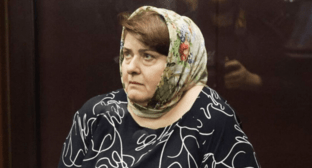29 May 2003, 13:27
Kalmyks
They call themselves khalmg (most likely, the word comes from the Turk word meaning ?the remaining? to describe the Oirats that didn?t take Islam; there are other explanations as well; in the Russian official documents the word Kalmyks appeared in the end of the 16th century, since the end of the 18th century Kalmyks themselves started to use this word). They form the main population of Kalmykia. They also live in Astrakhan, Volgograd, Rostov and Orenburg districts, In Stavropol territory, there are small groups in Siberia, Central Asia and in the Caucasus. Their population in the Russian Federation is 166 thousand people (1992), including over 146 thousand in Kalmykia. They belong to the Central Asian race of the big Mongoloid race, they differ a little from Mongols and Buriats. They speak Kalmyk language of the western sub-group of the Mongol group of the Altai branch. Since 1925 their literacy is based on Russian alphabet, before they used the common Oirat, the so-called tarokalmyk literacy todo bichig. Believers are Buddhists-Llamaists, part are Orthodox.
The ancestors of Kalmyks are Oirats. In the beginning of the 17th century part of the Oirat taishes moved to Russia, took Russian citizenship and received the grounds for leading the nomads? life in the lower parts of the rivers Volga and Ural. By the middle of the 17th century on these grounds there were about 280 thousand Kalmyks including the other ethnic sub-divisions of Oirats (Derbets, Torguts etc.) that retained their language, economical and cultural originality till the beginning of the 20th century. In 1771 part of the Kalmyk taishes unhappy with the strengthening oppression on behalf of the Russian government went back to Jungaria and took away about 125 thousand Kalmyks. Most of them perished on the way. Kalmyks that got separated and lived among the Cossacks along the Don, in the Urals and Ukraine, became Christians. Since the end of the 19th century capitalist relationships started to develop in Kalmykia. In the end of the 19th century Kalmiks consolidated as a united nation.
In 1920 Kalmyk Autonomous district was formed on their grounds; in 1935 it was transferred to the Autonomous Soviet Socialist Republic of Kalmykia. In 1943 their autonomy was abolished, they were moved away against the law. In 1957-58 the Autonomous Soviet Socialist Republic of Kalmykia was restored and the Karmiks could return to their ethnic territory.
The base of traditional economy was distant-pasture cattle breeding 9mainly sheep, as for the horses - their umber depended on the needs of the army; cattle, goats, camels). In the middle of the 19th century, when stationary villages appeared, Kalmyks started to breed pigs. Fishing and agriculture were known yet by Oirats. Torguts and Khoshuts that settled by the banks of the Volga river and the Caspian sea were fishermen. Since the second quarter of the 19th century bankrupt Kalmyks switched to settled agriculture or peonage. Artistic crafts were well-developed - embroidery (special multi-colored seams on female clothes), metal processing (chiseling and engraving of the metal parts of the saddle, bridle, knife cases and handles, smoking pipes, rifle butts, bracelets, earrings), embossing leather, wood carving (furniture, architectural details of the noble Kalmyk houses).
Traditional settlement had a circular shape - most convenient for the nomads from the point of view of defense. In the center of the circle they kept cattle at night, property, had meetings. Since the beginning of the 19th century there appeared stationary settlements with linear planning. There are three types of traditional dwelling: covered wagon, earthen house and semi-earthen house. Covered wagon is a tent of Mongol type. Poor people lived in earthen houses, the walls were made of raw of turf bricks, the roof was made of clay or turf. The entrance was from the south, the northern part was for the noble guests and the house altar; the right side was for men, the left side - for women.
Traditional male costume was a jerkin, a shirt, trousers, soft leather boots with a felt stocking for winter and fabric foot wraps for summer. Female dress - a long dress with a sleeveless jacket, under it - a long shirt and trousers, boots. Belts were of great importance, they indicated the rank and the wealth of their owners. Women?s belts were embroidered, men?s were metal. Head gears of men and women were very various and depended on the season, the wealth of the family etc. The festive head gear had a red silk tassel (hence the nickname of Kalmyks among the neighbor peoples - ?red tassels?). Female decorations - earrings, pins, hairpins, golden, silver and bone rings, precious and semiprecious stones; male decorations - an earring in the left ear, a ring on the ring finger, a bracelet that played the role of an amulet.
Main food was meat and milk. Preferred meat was mutton and beef, less popular was the meat of horses, camels, pork and game. Meat dishes: broth with meat seasoned with raw onions; meat baked in a covered dish (in the past - a barbecue baked in a hole covered with earth the whole day long, the fire was set on top of it); noodles with meat and onions; dumplings; finely chopped organs of a sheep. Dairy products - cheese, cottage cheese, sour cream, butter, milk skin, fermented horse milk, milk kvass (fermented drink) and a sour drink made of cow milk. Daily drink was tea with milk, butter, salt and spices. Farinaceous food - unleavened cakes bits of dough boiled in sheep fat, later - bagels and thick pancakes taken from Russians and Ukrainians.
Main Genres of folklore: slow songs, good wishes, proverbs, fairy-tales, heroic epic story ?Jangar? performed by the bards - jangarchi. There survived the elements of common Mongolian pre-Buddhist beliefs (shamanism, the cult of fire, water etc.) Professional culture is developing.




